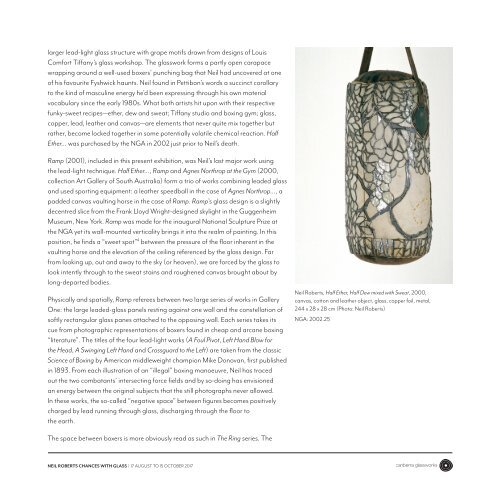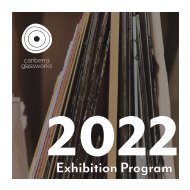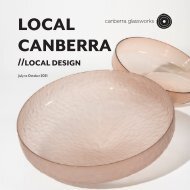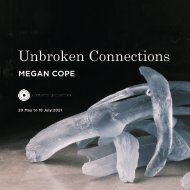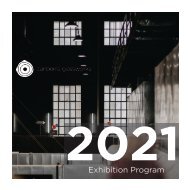Neil Roberts Chances with Glass
Neil Roberts (1954 – 2002) trained as a glassblower in the early 1980s but quickly evolved his practice to sculpture, often combining glass with other materials. He was fascinated with the vulnerable quality of glass and frequently invited fracture and repair into his processes of making. This exhibition focuses on Roberts’ interest in arenas of masculinity such as the boxing ring, gymnasium, farmyard and urban gangland. The tension between violence and tenderness he observed in such arenas found expression through his chancy collaborations with the glass medium.
Neil Roberts (1954 – 2002) trained as a glassblower in the early 1980s but quickly evolved his practice to sculpture, often combining glass with other materials. He was fascinated with the vulnerable quality of glass and frequently invited fracture and repair into his processes of making. This exhibition focuses on Roberts’ interest in arenas of masculinity such as the boxing ring, gymnasium, farmyard and urban gangland. The tension between violence and tenderness he observed in such arenas found expression through his chancy collaborations with the glass medium.
Create successful ePaper yourself
Turn your PDF publications into a flip-book with our unique Google optimized e-Paper software.
larger lead-light glass structure <strong>with</strong> grape motifs drawn from designs of Louis<br />
Comfort Tiffany’s glass workshop. The glasswork forms a partly open carapace<br />
wrapping around a well-used boxers’ punching bag that <strong>Neil</strong> had uncovered at one<br />
of his favourite Fyshwick haunts. <strong>Neil</strong> found in Pettibon’s words a succinct corollary<br />
to the kind of masculine energy he’d been expressing through his own material<br />
vocabulary since the early 1980s. What both artists hit upon <strong>with</strong> their respective<br />
funky-sweet recipes—ether, dew and sweat; Tiffany studio and boxing gym; glass,<br />
copper, lead, leather and canvas—are elements that never quite mix together but<br />
rather, become locked together in some potentially volatile chemical reaction. Half<br />
Ether… was purchased by the NGA in 2002 just prior to <strong>Neil</strong>’s death.<br />
Ramp (2001), included in this present exhibition, was <strong>Neil</strong>’s last major work using<br />
the lead-light technique. Half Ether…, Ramp and Agnes Northrop at the Gym (2000,<br />
collection Art Gallery of South Australia) form a trio of works combining leaded glass<br />
and used sporting equipment: a leather speedball in the case of Agnes Northrop…, a<br />
padded canvas vaulting horse in the case of Ramp. Ramp’s glass design is a slightly<br />
decentred slice from the Frank Lloyd Wright-designed skylight in the Guggenheim<br />
Museum, New York. Ramp was made for the inaugural National Sculpture Prize at<br />
the NGA yet its wall-mounted verticality brings it into the realm of painting. In this<br />
position, he finds a “sweet spot” 4 between the pressure of the floor inherent in the<br />
vaulting horse and the elevation of the ceiling referenced by the glass design. Far<br />
from looking up, out and away to the sky (or heaven), we are forced by the glass to<br />
look intently through to the sweat stains and roughened canvas brought about by<br />
long-departed bodies.<br />
Physically and spatially, Ramp referees between two large series of works in Gallery<br />
One: the large leaded-glass panels resting against one wall and the constellation of<br />
softly rectangular glass panes attached to the opposing wall. Each series takes its<br />
cue from photographic representations of boxers found in cheap and arcane boxing<br />
“literature”. The titles of the four lead-light works (A Foul Pivot, Left Hand Blow for<br />
the Head, A Swinging Left Hand and Crossguard to the Left) are taken from the classic<br />
Science of Boxing by American middleweight champion Mike Donovan, first published<br />
in 1893. From each illustration of an “illegal” boxing manoeuvre, <strong>Neil</strong> has traced<br />
out the two combatants’ intersecting force fields and by so-doing has envisioned<br />
an energy between the original subjects that the still photographs never allowed.<br />
In these works, the so-called “negative space” between figures becomes positively<br />
charged by lead running through glass, discharging through the floor to<br />
the earth.<br />
<strong>Neil</strong> <strong>Roberts</strong>, Half Ether, Half Dew mixed <strong>with</strong> Sweat, 2000,<br />
canvas, cotton and leather object, glass, copper foil, metal,<br />
244 x 28 x 28 cm (Photo: <strong>Neil</strong> <strong>Roberts</strong>)<br />
NGA: 2002.25<br />
The space between boxers is more obviously read as such in The Ring series. The<br />
NEIL ROBERTS CHANCES WITH GLASS | 17 AUGUST TO 15 OCTOBER 2017


